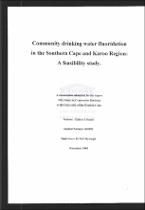| dc.contributor.advisor | Myburgh, Neil | |
| dc.contributor.author | Dennis, Gilbert J | |
| dc.date.accessioned | 2022-09-01T08:51:37Z | |
| dc.date.available | 2022-09-01T08:51:37Z | |
| dc.date.issued | 2002 | |
| dc.identifier.uri | http://hdl.handle.net/11394/9283 | |
| dc.description | Magister Chirurgiae Dentium (MChD) | en_US |
| dc.description.abstract | The prevalence of dental decay is high among lower socio-economic groups in the Southern Cape and Karoo region. 70 - S0% of State employed dentists' time in this region is spent on attempting to reduce the pain and sepsis within the communities for which the primary
treatment modality is extraction of the tooth under emergency conditions. In developing countries the prevalence of dental decay is still high. There is a general downward trend of dental decay in developing countries; and it is associated with combinations of: exposure to
fluoridated water and or other forms of fluoride exposure (e.g. in fluoridated tooth paste), the provision of preventive oral health services, an increase in dental awareness through organized oral health education programs and the readily available dental resources. This study looked at the feasibility of implementing community water fluoridation in the Southern Cape and Karoo Region by describing the primary drinking water sources, the population distribution around these sources and the actual levels of fluoride found in the water samples. Each sample was coded and with the use of a global positioning system (GPS), a set of co-ordinates obtained for each. Other options with regard to fluoride supplementation were explored as an attempt to provide an alternative intervention option for exposure to fluoride where community drinking water fluoridation was not the first option. This information will be used to record and update existing tables for fluoride levels in community drinking water of the communities in the Southern Cape and Karoo region that is currently used as a guide for prescribing fluoride supplementation as a means of prophylaxis for the prevention and reduction of dental decay. This study re-iterated the diverse set of variables that communities living in rural areas have to live with. It supports the trend that in developing countries the DMFT (12 years) and dmft (6 years) are higher than those in the same age cohorts of developed countries. This study shows that the fluoride level in borehole water is generally higher than that of dams or reservoirs | en_US |
| dc.language.iso | en | en_US |
| dc.publisher | University of the Western Cape | en_US |
| dc.subject | Southern Cape | en_US |
| dc.subject | Karoo Region | en_US |
| dc.subject | Fluoride-Ion Specific Electrode (FISE) | en_US |
| dc.subject | Peninsula Technicons | en_US |
| dc.subject | Total Ionic Strength Adjustment Buffer (TISAB) | en_US |
| dc.subject | Mossel Bay | en_US |
| dc.subject | Langkloof | en_US |
| dc.subject | Western Cape | en_US |
| dc.subject | the Department of Health (DOH) | en_US |
| dc.subject | Global Positioning System (GPS) | en_US |
| dc.title | Community drinking water fluoridation in the Southern Cape and Karoo Region: A feasibility study | en_US |
| dc.rights.holder | University of the Western Cape | en_US |

